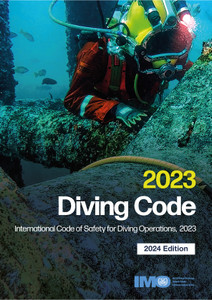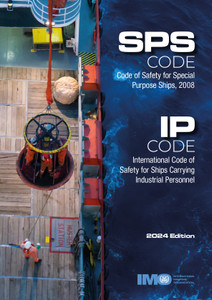
This publication contains the three most important IMO instruments dealing with life-saving appliances, namely the International Life-Saving Appliance (LSA) Code, the Revised Recommendation on Testing of Life-Saving Appliances and the Code of Practice for Evaluation, Testing and Acceptance of Prototype Novel Life-Saving Appliances
It provides international requirements for the life-saving appliances required by chapter III of the 1974 SOLAS Convention, including personal life-saving appliances like lifebuoys, lifejackets, immersion suits, anti-exposure suits and thermal protective aids; visual aids, such as parachute flares, hand flares and buoyant smoke signals; survival craft, such as life rafts and lifeboats; rescue boats; launching and embarkation appliances and marine evacuation systems line throwing appliances; and general alarm and public address systems.
This publication contains the three most important International Maritime Organization (IMO) instruments dealing with life-saving appliances, namely the International Life-Saving Appliance (LSA) Code, the Revised recommendation on testing of life-saving appliances and the Code of Practice for the Evaluation, Testing and Acceptance of Prototype Novel Life-Saving Appliances and Arrangements.
The International Life-Saving Appliance (LSA) Code was adopted by IMO?s Maritime Safety Committee (MSC) at its 66th session (June 1996) by resolution MSC.48(66). It provides international requirements for the life-saving appliances required by chapter III of the 1974 SOLAS Convention, including personal life-saving appliances
like lifebuoys, lifejackets, immersion suits, anti-exposure suits and thermal protective aids; visual aids, such as parachute flares, hand flares and buoyant smoke signals; survival craft, such as liferafts and lifeboats; rescue boats; launching and embarkation appliances and marine evacuation systems line-throwing appliances; and general alarm and public address systems.
The Code was made mandatory by resolution MSC.47(66) under SOLAS regulation III/3.10, whereby regulation III/34 determines that all life-saving appliances and arrangements shall comply with its requirements. The Code entered into force on 1 July 1998 and has been amended in accordance with SOLAS Article VIII,
as follows:
.1 by the May 2006 amendments, which were adopted by resolution MSC.207(81) and entered into force on 1 July 2010;
.2 by the December 2006 amendments, which were adopted by resolution MSC.218(82) and entered into force on 1 July 2008;
.3 by the December 2008 amendments, which were adopted by resolution MSC.272(85) and entered into force on 1 July 2010;
.4 by the May 2010 amendments, which were adopted by resolution MSC.293(87) and entered into force on 1 January 2012;
.5 by the May 2011 amendments, which were adopted by resolution MSC.320(89) and entered into force on 1 January 2013;
.6 by the May 2014 amendments, which were adopted by resolution MSC.368(93) and entered into force on 1 January 2016;
.7 by the June 2017 amendments, which were adopted by resolution MSC.425(98) and entered into force on 1 January 2020;
.8 by the June 2019 amendments, which were adopted by resolution MSC.459(101), to be in force as of 1 January 2024; and
.9 by the May 2021 amendments, which were adopted by resolution MSC.485(103), to be in force as of 1 January 2024.
The consolidated text of the LSA Code in the present publication incorporates the above nine sets of amendments that have been adopted by the Maritime Safety Committee to be in force as of 1 January 2024.
Additionally, the Code has been amended by the June 2023 amendments, which were adopted by resolution MSC.535(107), with the expected entry into force on 1 January 2026, pending the entry into force at the time of the preparation of this publication.
The above-mentioned amendments are incorporated as prospective amendments to the International Life-Saving Appliance Code for ease of reference, as set out in the additional information section, to be applicable upon the entry into force.
The referenced industry standards may have been withdrawn or revised since issue of this publication. The reader should make use of the latest versions of the referenced industry standards, if appropriate, taking into account the provisions of the Uniform wording for referencing IMO instruments (resolution A.911(22)),
indicating that when amended by the relevant industry organization, the revised edition of the standards should be approved by the relevant Committee.
Recommendations on the testing of life-saving appliances were first adopted by the IMO Assembly in 1991, by resolution A.689(17). In 1998, the MSC, recognizing the need to introduce more precise requirements
for the testing of life-saving appliances and recalling that it had amended the recommendations on several occasions since their adoption, adopted the Revised recommendation on testing of life-saving appliances (resolution MSC.81(70), as amended), effectively replacing resolution A.689(17). Since then, the revised recommendations have again been amended several times, in general corresponding to the associated LSA
Code amendments described above, and the present publication contains the consolidated text including the amendments adopted by resolutions MSC.200(80), MSC.226(82), MSC.274(85), MSC.295(87), MSC.321(89), MSC.323(89) (and its corrigendum), MSC.378(93), MSC.427(98), MSC.472(101), MSC.488(103) and MSC.544(107) in part, pending the effective date for some amendments contained in the resolution, as set out in the additional information section.
The Code of Practice for the Evaluation, Testing and Acceptance of Prototype Novel Life-Saving Appliances and Arrangements, adopted by the Assembly in 1983 by resolution A.520(13), is intended to cater for prototype novel life-saving appliances and arrangements which may be developed, and do not fully meet the requirements of chapter III of the 1974 SOLAS Convention, but provide the same or higher safety standards.
Foreword
International Life-Saving Appliance (LSA) Code
Resolution MSC.48(66).
Preamble.
Chapter I General
1.1 Definitions
1.2 General requirements for life-saving appliances.
Chapter II Personal life-saving appliances
2.1 Lifebuoys
2.2 Lifejackets
2.3 Immersion suits
2.4 Anti-exposure suits
2.5 Thermal protective aids
Chapter III Visual signals
3.1 Rocket parachute flares
3.2 Hand flares
3.3 Buoyant smoke signals
Chapter IV Survival craft
4.1 General requirements for liferafts
4.2 Inflatable liferafts
4.3 Rigid liferafts
4.4 General requirements for lifeboats
4.5 Partially enclosed lifeboats
4.6 Totally enclosed lifeboats
4.7 Free-fall lifeboats
4.8 Lifeboats with a self-contained air support system
4.9 Fire-protected lifeboats
Chapter V Rescue boats
5.1 Rescue boats
Chapter VI Launching and embarkation appliances
6.1 Launching and embarkation appliances
6.2 Marine evacuation systems
Chapter VII Other life-saving appliances
7.1 Line-throwing appliances
7.2 General alarm and public address system
Testing and Evaluation of Life-Saving Appliances
I Revised recommendation on testing of life-saving appliances.
Resolution MSC.81(70)
Introduction
Part 1 Prototype tests for life-saving appliances
1 Lifebuoys
1.1 Lifebuoys specification
1.2 Temperature cycling test
1.3 Drop test
1.4 Test for oil resistance
1.5 Fire test
1.6 Flotation test
1.7 Strength test
1.8 Test for operation with a light and smoke signal
1.9 Lifebuoy self-activating smoke signal tests
2 Lifejackets
2.1 Temperature cycling test
2.2 Buoyancy test
2.3 Fire test
2.4 Tests of components other than buoyancy materials
2.5 Strength tests
2.6 Tests for lifejacket buoyancy material
2.7 Donning test
2.8 Water performance tests
2.9 Infant and children?s lifejacket tests
2.10 Tests for inflatable lifejackets
3 Immersion suits, anti-exposure suits and thermal protective aids
3.1 Tests common to non-insulated and insulated immersion suits and anti-exposure suits
3.2 Thermal protective tests
3.3 Thermal protective aids for survival craft
4 Pyrotechnics ? rocket parachute flares, hand flares and buoyant smoke signals
4.1 General
4.2 Temperature tests
4.3 Water and corrosion resistance test
4.4 Handling safety test
4.5 Safety inspection
4.6 Rocket parachute flares test
4.7 Hand flares test
4.8 Buoyant smoke signals test
5 Liferafts ? rigid and inflatable
5.1 Drop test
5.2 Jump test.
5.3 Weight test
5.4 Towing test
5.5 Mooring out tests
5.6 Liferaft painter system test
5.7 Loading and seating test
5.8 Boarding and closing arrangement test
5.9 Stability test
5.10 Manoeuvrability test
5.11 Swamp test
5.12 Canopy closure test
5.13 Buoyancy of float-free liferafts
5.14 Detailed inspection
5.15 Weak link test
5.16 Davit-launched liferafts ? strength test of lifting components
5.17 Additional tests applicable to inflatable liferafts only
5.18 Additional tests applicable to automatically self-righting liferafts only
5.19 Submergence test for automatically self-righting and canopied reversible liferafts
5.20 Wind velocity tests
5.21 Test for self-draining of floors of canopied reversible liferafts and automatically self-righting liferafts
5.22 Liferaft light tests
6 Lifeboats
6.1 Definitions and general conditions
6.2 Lifeboat material tests
6.3 Lifeboat overload test
6.4 Davit-launched lifeboat impact and drop test
6.5 Free-fall lifeboat free-fall test
6.6 Lifeboat seating strength test
6.7 Lifeboat seating space test
6.8 Lifeboat freeboard and stability tests
6.9 Release mechanism test
6.10 Lifeboat operational test
Life-Saving Appliances
vi LIFE-SAVING APPLIANCES including LSA Code 2023 EDITION
6.11 Lifeboat towing and painter release test
6.12 Lifeboat light tests
6.13 Canopy erection test
6.14 Additional tests for totally enclosed lifeboats
6.15 Air supply test for lifeboats with a self-contained air support system
6.16 Additional tests for fire-protected lifeboats
6.17 Measuring and evaluating acceleration forces
7 Rescue boats and fast rescue boats
7.1 Rigid rescue boats
7.2 Inflated rescue boats
7.3 Rigid/inflated rescue boats
7.4 Rigid fast rescue boats
7.5 Inflated fast rescue boats
7.6 Rigid/inflated fast rescue boats
7.7 Outboard motors for rescue boats
8 Launching and embarkation appliances
8.1 Testing of davits and launching appliances
8.2 Davit-launched liferaft automatic release hook test
9 Line-throwing appliances
9.1 Test for pyrotechnics
9.2 Function test
9.3 Line tensile test
9.4 Visual examination
9.5 Temperature test
10 Position-indicating lights for life-saving appliances
10.1 Survival craft and rescue boats light tests
10.2 Lifebuoy self-igniting light tests
10.3 Lifejacket light tests
10.4 Common tests for all position-indicating lights.
11 Hydrostatic release units
11.1 Visual and dimensional examination
11.2 Technical tests
11.3 Performance test
12 Marine evacuation systems
12.1 Materials
12.2 Marine evacuation system container
12.3 Marine evacuation passage
Contents
LIFE-SAVING APPLIANCES including LSA Code 2023 EDITION vii
12.4 Marine evacuation platform, if fitted
12.5 Associated inflatable liferafts
12.6 Performance
13 Searchlights for lifeboats and rescue boats
13.1 Visual examination
13.2 Durability and resistance to environmental conditions
13.3 Operational controls
13.4 Light tests
Part 2 Production and installation tests
1 General
2 Individual buoyancy equipment
2.1 Lifejackets
2.2 Immersion and anti-exposure suits
3 Portable buoyancy equipment
3.1 Lifebuoys
4 Pyrotechnics
5 Survival craft
5.1 Liferaft operational inflation test
5.2 Davit-launched liferaft and inflated rescue boat test
5.3 Lifeboat and rescue boat test
5.4 Launch test
6 Launching and stowage arrangements
6.1 Launching appliances using falls and winches
6.2 Installation tests of liferaft launching appliances
7 Marine evacuation systems
7.1 Installation tests
Annex 1 ? Adult reference test device (RTD) design and construction
1 General
2 Materials
3 Construction
Annex 2 ? Child reference test device (RTD) design and construction
1 General
2 Materials
3 Construction
Annex 3 ? Infant reference test device (RTD) design and construction
1 General
2 Materials
3 Construction
Life-Saving Appliances
viii LIFE-SAVING APPLIANCES including LSA Code 2023 EDITION
II Code of Practice for the Evaluation, Testing and Acceptance of
Prototype Novel Life-Saving Appliances
and Arrangements
Resolution A.520(13)
Preamble
1 General provisions
2 General criteria
3 Appliance criteria and testing of prototypes
Additional information
Prospective amendments applicable to life-saving appliances
Resolution MSC.535(107)
Amendments to the International Life-Saving Appliance (LSA) Code
Resolution MSC.544(107)
Amendments to the Revised recommendation on testing of life-saving appliances
(resolution MSC.81(70))
IMO
As a specialised agency of the United Nations, the International Maritime Organization (IMO) is the global standard-setting authority for the safety, security and environmental performance of international shipping. Its main role is to create a regulatory framework for the shipping industry that is fair and effective, universally adopted and universally implemented.
In other words, its role is to create a level playing field so that ship operators cannot address their financial issues by simply cutting corners and compromising on safety, security and environmental performance. This approach also encourages innovation and efficiency.
Shipping is a truly international industry, and it can only operate effectively if the regulations and standards are themselves agreed, adopted and implemented on an international basis. And IMO is the forum at which this process takes place.
- Number of Pages:
- 296
- Published Date:
- October 2023
- Book Height:
- 250 mm
- Book Width:
- 210 mm
- Publication Date:
- October 2023
- Author:
IMO
- Weight:
- 0.7 kg
- Preview:
- Yes






